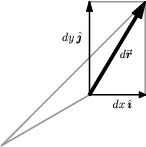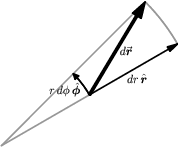Section 4.3 Other Coordinate Systems
¶It is important to realize that \(d\rr\) and \(ds\) are defined geometrically, not by the component expressions in (4.2.2) and (4.2.4). Because of this coordinate-independent nature of \(d\rr\text{,}\) it is possible and useful to study \(d\rr\) in another coordinate system, such as polar coordinates (\(r\text{,}\)\(\phi\)) in the plane. 1 It is then natural to use basis vectors \(\{\rhat,\phat\}\) adapted to these coordinates, with \(\rhat\) being the unit vector in the radial direction, and \(\phat\) being the unit vector in the direction of increasing \(\phi\text{;}\) see Section 3.8. 2


By determining the lengths of the sides of the infinitesimal polar “rectangle” shown in the last drawing of Figure 4.3.1, one obtains
Notice the factor of \(r\) in the \(\phat\) term; \(d\phi\) by itself is not a length. The length of an infinitesimal arc is \(r\,d\phi\text{.}\) Using (4.2.3) to find the length of \(d\rr\) as before leads to
which is the infinitesimal Pythagorean Theorem in polar coordinates.